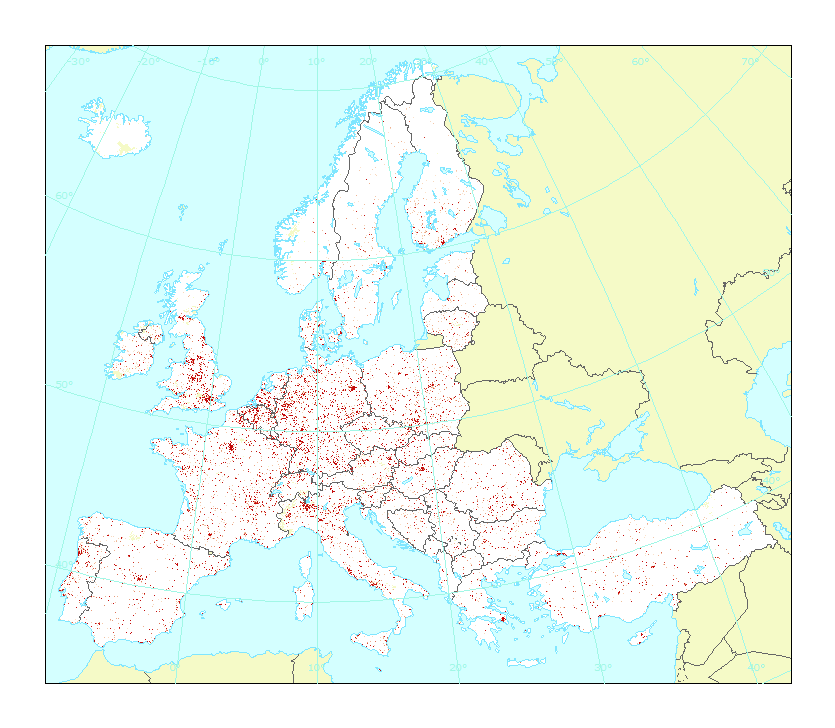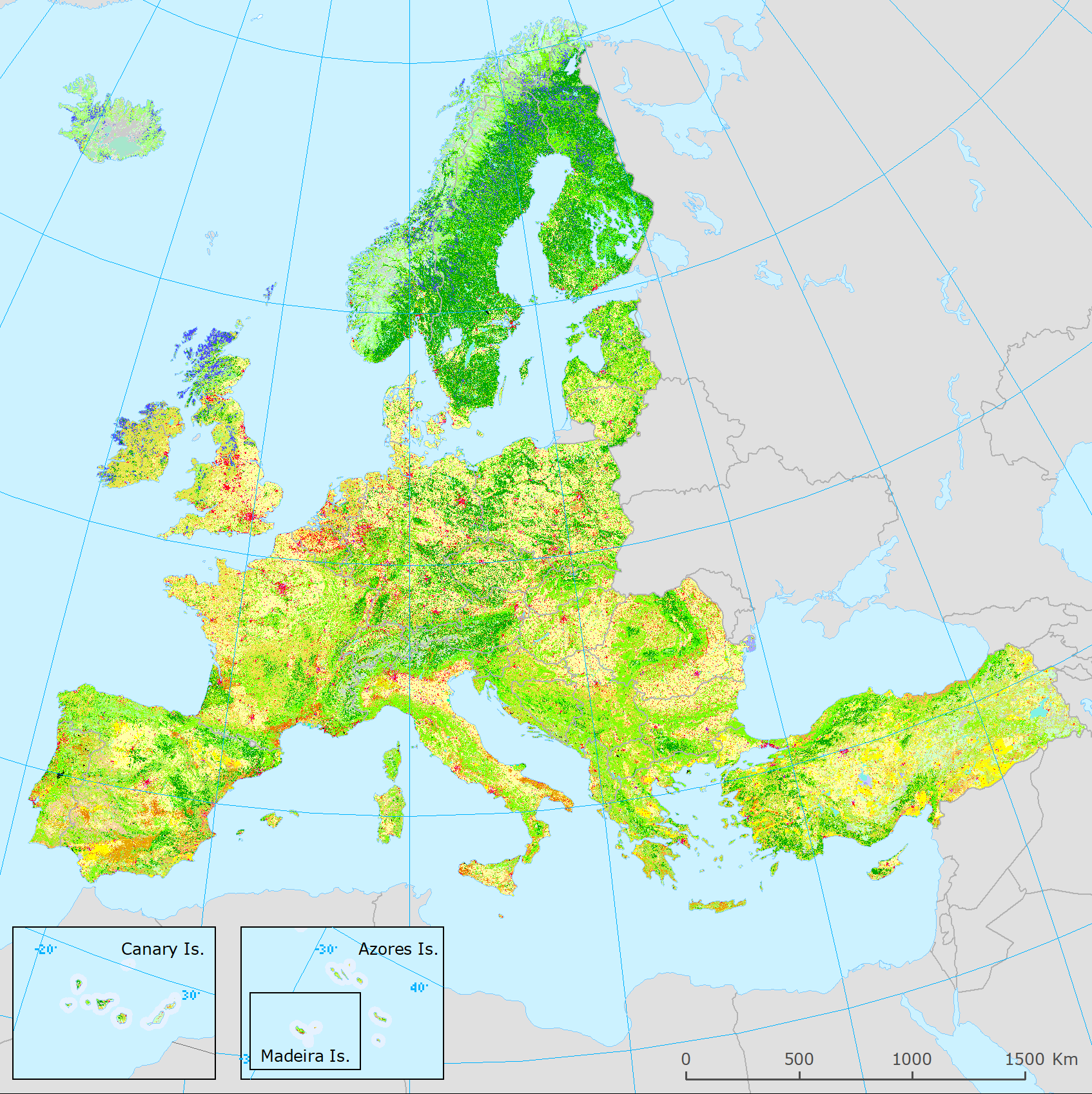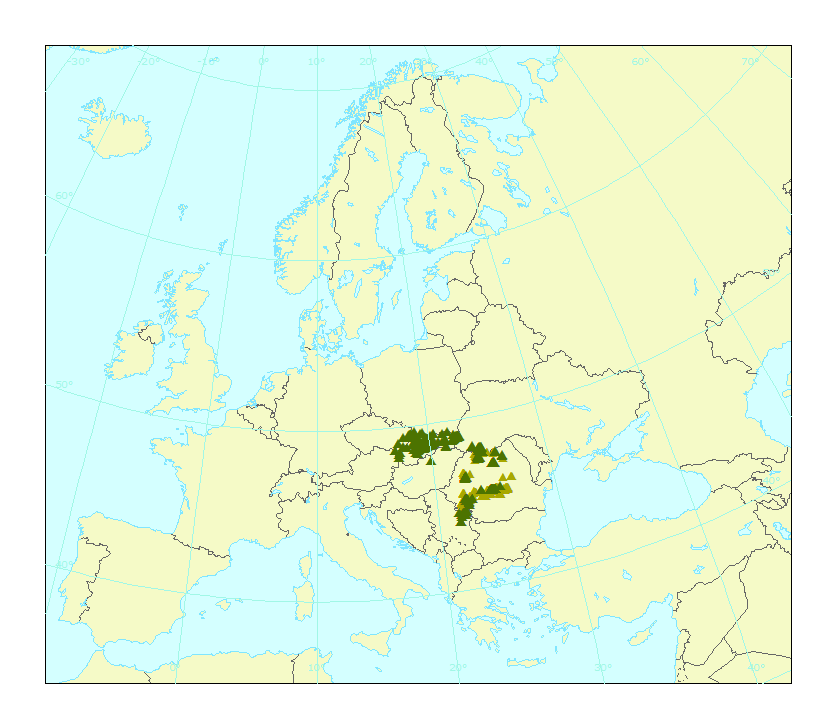2019
Type of resources
Available actions
Topics
INSPIRE themes
Keywords
Contact for the resource
Provided by
Years
Formats
Representation types
Update frequencies
status
Service types
Scale
Resolution
-

The current resource was derived from original Copernicus High Resolution Layer Imperviousness Density 2015 product for the purposes of imperviousness indicator (LSI002) calculations within the EEA LEAC CUBE environment. The dataset is also input to the imperviousness indicator itself. The high resolution imperviousness products capture the percentage and change of soil sealing. Built-up areas are characterized by the substitution of the original (semi-) natural land cover or water surface with an artificial, often impervious cover. These artificial surfaces are usually maintained over long periods of time. A series of high resolution imperviousness datasets (for the 2006, 2009, 2012 and 2015 reference years) with all artificially sealed areas was produced using automatic derivation based on calibrated Normalized Difference Vegetation Index (NDVI). This series of imperviousness layers constitutes the main status layers. They are per-pixel estimates of impermeable cover of soil (soil sealing) and are mapped as the degree of imperviousness (0-100%). Imperviousness change layers were produced as a difference between the reference years (2006-2009, 2009-2012, 2012-2015 and additionally 2006-2012, to fully match the CORINE Land Cover production cycle) and are presented 1) as degree of imperviousness change (100% - +100%), in 20m and 100m pixel size, and 2) a classified (categorical) 20m change product. The latest version (published: 15/01/2019) of 100m resolution imperviousness status layers represents a time series consistent with 100m resolution imperviousness change layers - the cell by cell difference of the degree of imperviousness status corresponds to the degree of imperviousness change. The production of the High Resolution Imperviousness products was coordinated by the European Environment Agency in the frame of the EU Copernicus programme.
-

The current resource was derived from original Copernicus High Resolution Layer Imperviousness Density 2012 product for the purposes of imperviousness indicator (LSI002) calculations within the EEA LEAC CUBE environment. The dataset is also input to the imperviousness indicator itself. The high resolution imperviousness products capture the percentage and change of soil sealing. Built-up areas are characterized by the substitution of the original (semi-) natural land cover or water surface with an artificial, often impervious cover. These artificial surfaces are usually maintained over long periods of time. A series of high resolution imperviousness datasets (for the 2006, 2009, 2012 and 2015 reference years) with all artificially sealed areas was produced using automatic derivation based on calibrated Normalized Difference Vegetation Index (NDVI). This series of imperviousness layers constitutes the main status layers. They are per-pixel estimates of impermeable cover of soil (soil sealing) and are mapped as the degree of imperviousness (0-100%). Imperviousness change layers were produced as a difference between the reference years (2006-2009, 2009-2012, 2012-2015 and additionally 2006-2012, to fully match the CORINE Land Cover production cycle) and are presented 1) as degree of imperviousness change (100% - +100%), in 20m and 100m pixel size, and 2) a classified (categorical) 20m change product. The latest version (published: 15/01/2019) of 100m resolution imperviousness status layers represents a time series consistent with 100m resolution imperviousness change layers - the cell by cell difference of the degree of imperviousness status corresponds to the degree of imperviousness change. The production of the High Resolution Imperviousness products was coordinated by the European Environment Agency in the frame of the EU Copernicus programme.
-

UWWTD Discharge Points, Oct. 2019 is one of the datasets produced within the frame of the reporting under 10th UWWTD Art.15 reporting period (UWWTD data call 2017). The Urban Waste Water Treatment Directive (UWWTD) (91/271/EEC) obliges Member States to report data on the implementation of the Directive upon request from the European Commission bi-annually. Reported data include receiving areas as designated under UWWTD, agglomerations, urban waste water treatment plants serving the agglomerations and points of discharges. Dataset UWWTD_DischargePoints contains information on individual points of discharge from urban waste water treatment plants or collecting systems, including their coordinates of discharge, link to specific treatment plant, type of receiving area into which the effluent / wastewater is discharged, related waterbody (or river basin), information on the discharge on land and potential reuse of the treated waste water. The public dataset of discharge points is not used in published UWWTD maps (https://www.eea.europa.eu/themes/water/european-waters/water-use-and-environmental-pressures/uwwtd/interactive-maps/urban-waste-water-treatment-maps-2) for the time being. The source discharge points dataset is available in tabular format through the EEA website (https://www.eea.europa.eu/data-and-maps/data/waterbase-uwwtd-urban-waste-water-treatment-directive-6). The full (internal) dataset including inactive discharge points is available under "Urban Waste Water Treatment Directive, Discharge points reported under UWWTD data call 2017 - INTERNAL VERSION - Oct. 2019"
-

This dataset is the new version of the Effective Mesh Density (seff) 2016 dataset with improved input data, for the year 2015. This new dataset uses the Copernicus Imperviousness and the TomTom TeleAtlas datasets as fragmenting geometries. The Effective Mesh Density (seff) is a measure of the degree to which movement between different parts of the landscape is interrupted by a Fragmentation Geometry (FG). FGs are defined as the presence of impervious surfaces and traffic infrastructure, including medium sized roads. The more FGs fragment the landscape, the higher the effective mesh density hence the higher the fragmentation. The geographic coverage of the dataset is EEA39. An important consequence of landscape fragmentation is the increased isolation of ecosystem patches that breaks the structural connections and decreases resilience and ability of habitats to provide various ecosystem services. Fragmentation also influences human communities, agriculture, recreation and overall quality of life. Monitoring how fragmentation decreases landscape quality and changes the visual perception of landscapes provides information for policy measures that aim at improving ecosystem condition and restoration as well as maintaining the attractiveness of landscapes for recreational activities.
-

The present 100m raster dataset is the 2018 CLC status layer modified for the purpose of consistent statistical analysis in the land cover change accounting system at EEA. CORINE Land Cover (CLC) data are produced from 1986 for European (EEA member or cooperating) countries. Altogether five mapping inventories were implemented in this period, producing five status layers (CLC1990, CLC2000, CLC2006, CLC2012, CLC2018) and four CLC-Change (CLCC) layers for the corresponding periods (1990-2000, 2000-2006, 2006-2012, 2012-2018). Pan-European CLC and CLCC data are available as vector and raster products. Due to the technical characteristics of CLC and CLCC data, the evolution in CLC update methodology and in quality of input data, time-series statistics derived directly from historical CLC data includes several inconsistencies. In order to create a statistically solid basis for CLC-based time series analysis, a harmonization methodology was elaborated.
-

UWWTD Agglomerations, Oct. 2019 is one of the datasets produced within the frame of the reporting under 10th UWWTD Art.15 reporting period (UWWTD data call 2017). The Urban Waste Water Treatment Directive (UWWTD) (91/271/EEC) obliges Member States to report data on the implementation of the Directive upon request from the European Commission bi-annually. Reported data include receiving areas as designated under UWWTD, agglomerations, urban waste water treatment plants serving the agglomerations and points of discharges. Dataset UWWTD_Agglomerations contains agglomerations reported by countries with generated load ≥ 2000 p.e. (or even smaller), including names, coordinates, generated load and information whether the load generated is collected through collecting system or addressed via Individual Appropriate Systems (IAS) or not collected not addressed via IAS. This internal dataset contains all reported agglomerations, including inactive ones. Agglomerations with obviously wrong coordinates were excluded only. The public dataset excluding inactive agglomerations can be found under the entry "Urban Waste Water Treatment Directive, Agglomerations - PUBLIC VERSION - Oct. 2019".
-

The current dataset was derived from original Copernicus High Resolution Layer Imperviousness Density 2009 product product for the purposes of imperviousness indicator (LSI002) calculations within the EEA LEAC CUBE environment. The dataset is also input to the imperviousness indicator itself. The high resolution imperviousness products capture the percentage and change of soil sealing. Built-up areas are characterized by the substitution of the original (semi-) natural land cover or water surface with an artificial, often impervious cover. These artificial surfaces are usually maintained over long periods of time. A series of high resolution imperviousness datasets (for the 2006, 2009, 2012 and 2015 reference years) with all artificially sealed areas was produced using automatic derivation based on calibrated Normalized Difference Vegetation Index (NDVI). This series of imperviousness layers constitutes the main status layers. They are per-pixel estimates of impermeable cover of soil (soil sealing) and are mapped as the degree of imperviousness (0-100%). Imperviousness change layers were produced as a difference between the reference years (2006-2009, 2009-2012, 2012-2015 and additionally 2006-2012, to fully match the CORINE Land Cover production cycle) and are presented 1) as degree of imperviousness change (100% - +100%), in 20m and 100m pixel size, and 2) a classified (categorical) 20m change product. The latest version (published: 15/01/2019) of 100m resolution imperviousness status layers represents a time series consistent with 100m resolution imperviousness change layers - the cell by cell difference of the degree of imperviousness status corresponds to the degree of imperviousness change. The production of the High Resolution Imperviousness products was coordinated by the European Environment Agency in the frame of the EU Copernicus programme.
-

The present 100m raster dataset is the 2012 CLC status layer modified for the purpose of consistent statistical analysis in the land cover change accounting system at EEA. CORINE Land Cover (CLC) data are produced from 1986 for European (EEA member or cooperating) countries. Altogether five mapping inventories were implemented in this period, producing five status layers (CLC1990, CLC2000, CLC2006, CLC2012, CLC2018) and four CLC-Change (CLCC) layers for the corresponding periods (1990-2000, 2000-2006, 2006-2012, 2012-2018). Pan-European CLC and CLCC data are available as vector and raster products. Due to the technical characteristics of CLC and CLCC data, the evolution in CLC update methodology and in quality of input data, time-series statistics derived directly from historical CLC data includes several inconsistencies. In order to create a statistically solid basis for CLC-based time series analysis, a harmonization methodology was elaborated.
-
Location of landfills of waste Sites
-

The virgin forest inventory data set includes the location (point) of the last virgin forests identified by each Carpathians Convention Member, namely Czechia, Hungary, Romania, Serbia, Slovakia, and Ukraine. The data set does not include plots from Poland, since no official inputs have been submitted yet. An additional layer presents the quasi virgin forest plots provided by Romania. The virgin forest inventory inputs were collected and validated in 2019. The attribute table indicates, when available and along the virgin forest location, additional information as the official name, size, the county to which it belongs, altitude, level of protection, the forest type according to the national classification and its correspondence with the European Nature Information System classes (EUNIS). The Carpathians area of study is delimited by the Carpathian Environment Outlook (KEO) boundary.
 RUC Geo-Data catalogue
RUC Geo-Data catalogue